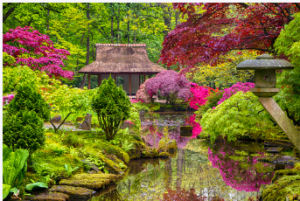Posted on May 25, 2023
Landscape Design – The Five Elements and the Principles of Composition
Landscape design is an art that necessitates an in-depth knowledge of five elements and principles of composition. Whether designing your garden yourself or hiring a professional landscaper, these concepts will help create an aesthetically pleasing yet functional space.
The line is an element that creates formal character through structure and forcefulness, giving any event its formal style. Straight lines draw your guests’ focus toward an area and can encourage quick movement, while curves help promote more everyday activities.
Composition
 Landscape designers must know how to combine various plants, materials, features and objects into a harmonious whole by understanding compositional principles such as balance, proportion, form, colour and line. The composition creates a sense of unity within a landscape design by unifying all design elements under a theme.
Landscape designers must know how to combine various plants, materials, features and objects into a harmonious whole by understanding compositional principles such as balance, proportion, form, colour and line. The composition creates a sense of unity within a landscape design by unifying all design elements under a theme.
The landscape design Adelaide uses lines as boundaries to demarcate plant beds and hardscape materials, whether plant beds or hardscape materials. Lines may be structural or sculptural in form; they may highlight shape, create patterns, natural eye movement or assert dominance over others.
Straight lines are formal, often associated with symmetrical balance and intended to draw the eye in one direction; on the other hand, curvy lines tend to be more natural and asymmetrical, softening hardscape edges and structures while drawing attention toward specific focal points.
Grouping landscape elements in odd numbers helps foster a sense of cohesion by limiting their use to one shape or type of object and alternating textures and colours throughout. By contrast, overusing one element could quickly overwhelm its surrounding environment.
Line
The line is one of the most accessible landscape design Adelaide elements and significantly impacts how a garden feels. The type of line used can determine a garden’s style–straight lines create formal environments, while curvier ones suit informal gardens better. Horizontal lines help move eyes across a garden more freely, while vertical ones draw them upward.
Form refers to the shape of plants or built structures in a landscape. The condition can take many situations, from formal garden hedge clippings to natural stream patterns or an irregular lawn design in informal landscaping environments. Furthermore, plant forms may help balance symmetrical and asymmetrical designs in their composition.
Colour is another essential aspect of landscape design. It can have an incredible impact on a garden’s appearance, so selecting hues that will work at different times of the day – for instance, bright sunlight makes specific colours appear more intense. At the same time, winter’s diffused illumination creates more subdued tones. Colour can also highlight other permanent features in your landscape, such as lines, textures and forms.
Form
Form refers to the form of plants and hardscape elements. Plants come in various shapes – upright, round, weeping, freeform and naturalistic. Hardscape elements include paving materials, walls, steps and pergolas that may all take different shapes, and forms can even be adjusted to achieve a symmetrical or asymmetrical balance in their composition.
Professional landscape designers can help you realise the look of your dreams by combining horticultural science, spatial organisation and artful composition into their design process. To get the best out of this journey, know what you want and understand budgetary constraints before meeting with a landscape designer.
Colour
Colour can be one of landscape design’s most engaging and challenging elements and significant rewards. Colour can make an object stand out in its surroundings or blend seamlessly into its environment; additionally, colours create mood or atmosphere in any given space: warm hues like reds and oranges can energise spaces, while cooler ones like blues and purples bring calm.
Colour in a landscape comes from several sources: flowers, foliage, bark and fruit of plants as well as hardscape materials such as pavers, wood and concrete; it may also come from paint finishes on buildings, fences or other structures; colour harmony can be achieved through manipulation of essential design elements like line, form, scale texture colour.
To achieve harmony within a garden, employ colours that complement one another – for instance, yellow and green go well together, or red and orange go nicely – such as yellow and green or red and orange. Analogous hues may also help soften transitions between different parts of your garden. For instance, pinks and whites may help ease transitions between burgundy ‘Redbor’ kale and white sweet alyssum plants.
Texture
Texture refers to the roughness or smoothness of plant leaves, bark and stems.
Coarse textures tend to have the greatest visual weight in landscape design yet can still be used effectively with other textures and forms.
Texture can alter our perception of scale and distance within landscapes. Customers can utilise coarse and fine textures to make their garden appear larger by placing coarse plants at the periphery and fine ones closer to viewers. Colour can also impact the surface; bold hues deepen contrast while muted hues lessen it – all these factors together create mesmerising effects in their garden landscapes.
